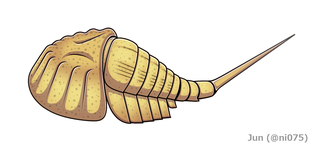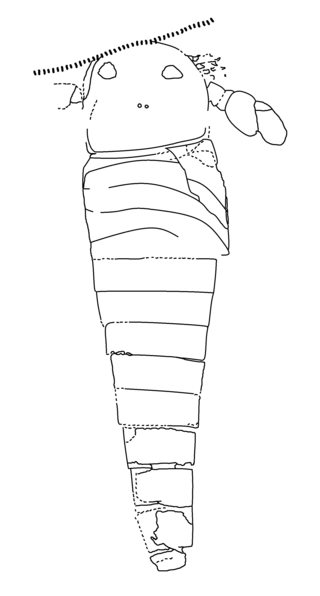
Eurypterids, often informally called sea scorpions, are a group of extinct arthropods that form the order Eurypterida. The earliest known eurypterids date to the Darriwilian stage of the Ordovician period 467.3 million years ago. The group is likely to have appeared first either during the Early Ordovician or Late Cambrian period. With approximately 250 species, the Eurypterida is the most diverse Paleozoic chelicerate order. Following their appearance during the Ordovician, eurypterids became major components of marine faunas during the Silurian, from which the majority of eurypterid species have been described. The Silurian genus Eurypterus accounts for more than 90% of all known eurypterid specimens. Though the group continued to diversify during the subsequent Devonian period, the eurypterids were heavily affected by the Late Devonian extinction event. They declined in numbers and diversity until becoming extinct during the Permian–Triassic extinction event 251.9 million years ago.

Xiphosura is an order of arthropods related to arachnids. They are more commonly known as horseshoe crabs. They first appeared in the Hirnantian. Currently, there are only four living species. Xiphosura contains one suborder, Xiphosurida, and several stem-genera.

Chasmataspidids, sometime referred to as chasmataspids, are a group of extinct chelicerate arthropods that form the order Chasmataspidida. Chasmataspidids are probably related to horseshoe crabs (Xiphosura) and/or sea scorpions (Eurypterida), with more recent studies suggest that they form a clade (Dekatriata) with Eurypterida and Arachnida. Chasmataspidids are known sporadically in the fossil record through to the mid-Devonian, with possible evidence suggesting that they were also present during the late Cambrian. Chasmataspidids are most easily recognised by having an opisthosoma divided into a wide forepart (preabdomen) and a narrow hind part (postabdomen) each comprising 4 and 9 segments respectively. There is some debate about whether they form a natural group.

Willwerathia is a genus of Devonian arthropod. It is sometimes classified as synziphosurine, a paraphyletic group of horseshoe crab-like fossil chelicerate arthropods, while some studies compare its morphology to an artiopod. Willwerathia known only by one species, Willwerathia laticeps, discovered in deposits of the Devonian period from the Klerf Formation, in the Rhenish Slate Mountains of Germany.
Bunaia is a genus of synziphosurine, a paraphyletic group of fossil chelicerate arthropods. Bunaia was tentatively placed as part of the clade Planaterga. The genus contains at least one species: Bunaia woodwardi from the Silurian period in Svalbard, Norway. Only a few morphological information of B. woodwardi had been confirmed, as the species known only from poorly preserved specimens compose of semicircular carapace, fragments of opisthosoma and disarticulated telson. The placement of "Bunaia" heintzi within this genus had been questioned and required further investigation.

Bunodes is a genus of synziphosurine, a paraphyletic group of fossil chelicerate arthropods. Bunodes was regarded as part of the clade Planaterga. Fossils of the single and type species, B. lunula, have been discovered in deposits of the Silurian period in Ludlow, England. Bunodes is the type genus of the family Bunodidae, the other genera of the same family being Limuloides.

Cyamocephalus is a genus of synziphosurine, a paraphyletic group of fossil chelicerate arthropods. Cyamocephalus was regarded as part of the clade Planaterga. Fossils of the single and type species, C. loganensis, have been discovered in deposits of the Silurian-aged Patrick Burn Formation in Lesmahagow, Scotland. Cyamocephalus is one of the two members of the family Pseudoniscidae, the other being Pseudoniscus. Cyamocephalus differ from Pseudoniscus by the fused tergites of 6th and 7th opisthosomal segments.

Legrandella is a genus of synziphosurine, a paraphyletic group of fossil chelicerate arthropods. Legrandella was regarded as part of the clade Prosomapoda. Fossils of the single and type species, L. lombardii, have been discovered in deposits of the Devonian period in Cochabamba, Bolivia.

Limuloides is a genus of synziphosurine, a paraphyletic group of fossil chelicerate arthropods. Limuloides was regarded as part of the clade Planaterga. Fossils of the genus have been discovered in deposits of the Silurian period in the United Kingdom and potentially in the United States. Limuloides is one of the two genera of the family Bunodidae, the other being the type genus Bunodes. Limuloides is characterized by a carapace with radiated ridges and serrated lateral regions, and an opisthosoma with rows of nodes. Limuloides was once though to have lateral compound eyes on its carapace, but later investigation did not find any evidence of it.

Pasternakevia is a genus of synziphosurine, a paraphyletic group of fossil chelicerate arthropods. Pasternakevia was regarded as part of the clade Planaterga. Fossils of the single and type species, P. podolica, have been discovered in deposits of the Silurian period in Podolia, Ukraine.

Pseudoniscus is a genus of synziphosurine, a paraphyletic group of fossil chelicerate arthropods. Pseudoniscus was regarded as part of the clade Planaterga. Fossils of the genus have been discovered in deposits of the Silurian period in the United Kingdom, the United States and Estonia. Pseudoniscus is one of the two members of the family Pseudoniscidae, the other being Cyamocephalus.

Weinbergina is a genus of synziphosurine, a paraphyletic group of fossil chelicerate arthropods. Fossils of the single and type species, W. opitzi, have been discovered in deposits of the Devonian period in the Hunsrück Slate, Germany.

Synziphosurina is a paraphyletic group of chelicerate arthropods previously thought to be basal horseshoe crabs (Xiphosura). It was later identified as a grade composed of various basal euchelicerates, eventually excluded form the monophyletic Xiphosura sensu stricto and only regarded as horseshoe crabs under a broader sense. Synziphosurines survived at least since early Ordovician to early Carboniferous in ages, with most species are known from the in-between Silurian strata.

Borchgrevinkium is an extinct genus of chelicerate arthropod. A fossil of the single and type species, B. taimyrensis, has been discovered in deposits of the Early Devonian period in the Krasnoyarsk Krai, Siberia, Russia. The name of the genus honors Carsten Borchgrevink, an Anglo-Norwegian explorer who participated in many expeditions to Antarctica. Borchgrevinkium represents a poorly known genus whose affinities are uncertain.

Dvulikiaspis is a genus of chasmataspidid, a group of extinct aquatic arthropods. Fossils of the single and type species, D. menneri, have been discovered in deposits of the Early Devonian period in the Krasnoyarsk Krai, Siberia, Russia. The name of the genus is composed by the Russian word двуликий (dvulikij), meaning "two-faced", and the Ancient Greek word ἀσπίς (aspis), meaning "shield". The species name honors the discoverer of the holotype of Dvulikiaspis, Vladimir Vasilyevich Menner.

Houia is an extinct genus of dekatriatan, a clade of chelicerate arthropods. Fossils of Houia have been discovered in deposits of the Early Devonian period in Guangxi and Yunnan, both in China. The genus contains two species: H. guangxiensis, from the Pragian to Emsian epoch of Guangxi; and H. yueya, the type species, from the Lochkovian epoch of Yunnan. The name of the genus is derived from the Chinese character 鲎 (hòu), meaning "horseshoe crab".

Bunodidae is an extinct family of synziphosurine chelicerates that lived in the Silurian. Bunodidae is classified inside the clade Planaterga alongside Pseudoniscidae and Dekatriata. Bunodidae is composed by two genera, Bunodes and Limuloides.

Venustulus is a genus of synziphosurine, a paraphyletic group of fossil chelicerate arthropods. Venustulus was regarded as part of the clade Prosomapoda. Fossils of the single and type species, V. waukeshaensis, have been discovered in deposits of the Silurian period in Wisconsin, in the United States. Venustulus is one of the few synziphosurine genera with fossil showing evidence of appendages, the other ones being Weinbergina, Anderella and Camanchia. Despite often being aligned close to horseshoe crabs, it has been found that Venustulus and its relatives form a group made up of various basal euchelicerate arthropods more distant to the xiphosurans.

Camanchia is a genus of synziphosurine, a paraphyletic group of fossil chelicerate arthropods. Camanchia was regarded as part of the clade Prosomapoda. Fossils of the single and type species, C. grovensis, have been discovered in deposits of the Silurian period in Iowa, in the United States. Alongside Venustulus, Camanchia is one of the only Silurian synziphosurine with fossil showing evidence of appendages.

Anderella is a genus of synziphosurine, a paraphyletic group of fossil chelicerate arthropods. Anderella was regarded as part of the clade Prosomapoda. Fossils of the single and type species, A. parva, have been discovered in deposits of the Carboniferous period in Montana, in the United States. Anderella is the first and so far the only Carboniferous synziphosurine being described, making it the youngest member of synziphosurines. Anderella is also one of the few synziphosurine genera with fossil showing evidence of appendages, but the details are obscure due to their poor preservation.



















